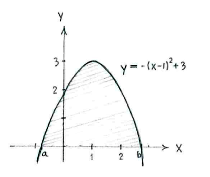Lösung 2.1:4b
Aus Online Mathematik Brückenkurs 2
K (Robot: Automated text replacement (-[[Bild: +[[Image:)) |
|||
| (Der Versionsvergleich bezieht 8 dazwischen liegende Versionen mit ein.) | |||
| Zeile 1: | Zeile 1: | ||
| - | {{ | + | Durch quadratische Ergänzung erhalten wir |
| - | < | + | |
| - | {{ | + | {{Abgesetzte Formel||<math>\begin{align} |
| - | {{ | + | y &= -x^2 + 2x + 2\\[5pt] |
| - | < | + | &= -\bigl(x^2 - 2x- 2\bigr)\\[5pt] |
| - | {{ | + | &= -\bigl((x-1)^2 - 1^2 - 2\bigr)\\[5pt] |
| - | {{ | + | &= -(x-1)^2 + 3 \textrm{.} |
| - | < | + | \end{align}</math>}} |
| - | {{ | + | |
| - | {{ | + | Wir sehen, dass die Funktion eine Parabel mit dem Maximum <math>y=3</math> bei <math>x=1</math> ist. |
| - | < | + | |
| - | {{ | + | [[Image:2_1_4_b.gif|center]] |
| + | |||
| + | Die Fläche, die wir bestimmen sollen, ist im Bild schraffiert. | ||
| + | |||
| + | Diese Fläche bestimmen wir mit dem Integral | ||
| + | |||
| + | {{Abgesetzte Formel||<math>\text{Fläche} = \int\limits_a^b \bigl(-x^2+2x+2\bigr)\,dx\,,</math>}} | ||
| + | |||
| + | wobei ''a'' und ''b'' die Schnittstellen der Parabel und der ''x''-Achse sind, also die Wurzeln von | ||
| + | |||
| + | {{Abgesetzte Formel||<math>0=-x^{2}+2x+2</math>}} | ||
| + | |||
| + | oder, durch quadratische Ergänzung (siehe oben) | ||
| + | |||
| + | {{Abgesetzte Formel||<math>0=-(x-1)^2+3 \textrm{,}</math>}} | ||
| + | |||
| + | also | ||
| + | |||
| + | {{Abgesetzte Formel||<math>(x-1)^2=3\,\textrm{.}</math>}} | ||
| + | |||
| + | Die Gleichung hat also die Wurzeln <math>x = 1\pm \sqrt{3}\</math> , <math>x=1-\sqrt{3}</math> und <math>x=1+\sqrt{3}\</math>. | ||
| + | |||
| + | Die Fläche ist also | ||
| + | |||
| + | {{Abgesetzte Formel||<math>\text{Fläche} = \int\limits_{1-\sqrt{3}}^{1+\sqrt{3}} \bigl(-x^2+2x+2\bigr)\,dx\,\textrm{.}</math>}} | ||
| + | |||
| + | Wir schreiben hier den Integranden in die quadratisch ergänzte Form. | ||
| + | |||
| + | {{Abgesetzte Formel||<math>\text{Fläche} = \int\limits_{1-\sqrt{3}}^{1+\sqrt{3}} \bigl( -(x-1)^2 + 3\bigr)\,dx\,,</math>}} | ||
| + | |||
| + | So erhalten wir die Stammfunktion | ||
| + | |||
| + | {{Abgesetzte Formel||<math>\text{Fläche} = \Bigl[\ -\frac{(x-1)^3}{3} + 3x\ \Bigr]_{1-\sqrt{3}}^{1+\sqrt{3}}\,</math>.}} | ||
| + | |||
| + | Daraus folgt | ||
| + | |||
| + | {{Abgesetzte Formel||<math>\begin{align} | ||
| + | \text{Fläche} &= -\frac{(1+\sqrt{3}-1)^3}{3}+3(1+\sqrt{3}\,)-\Bigl(-\frac{(1-\sqrt{3}-1)^3}{3}+3(1-\sqrt{3}\,)\Bigr)\\[5pt] | ||
| + | &= -\frac{(\sqrt{3}\,)^3}{3} + 3 + 3\sqrt{3} + \frac{(-\sqrt{3}\,)^3}{3} - 3 + 3\sqrt{3}\\[5pt] | ||
| + | &= -\frac{\sqrt{3}\sqrt{3}\sqrt{3}}{3} + 3\sqrt{3} + \frac{(-\sqrt{3}\,)(-\sqrt{3}\,)(-\sqrt{3}\,)}{3} + 3\sqrt{3}\\[5pt] | ||
| + | &= -\frac{3\sqrt{3}}{3} + 3\sqrt{3} - \frac{3\sqrt{3}}{3} + 3\sqrt{3}\\[5pt] | ||
| + | &= -\sqrt{3} + 3\sqrt{3} - \sqrt{3} + 3\sqrt{3}\\[5pt] | ||
| + | &= (-1+3-1+3)\sqrt{3}\\[5pt] | ||
| + | &= 4\sqrt{3}\,\textrm{.} | ||
| + | \end{align}</math>}} | ||
| + | |||
| + | Hinweis: Die Rechnungen werden umständlich, wenn wir mit dem Ausdruck | ||
| + | |||
| + | {{Abgesetzte Formel||<math>\int\limits_{1-\sqrt{3}}^{1+\sqrt{3}}{\bigl(-x^2+2x+2 \bigr)}\,dx = \cdots</math>}} | ||
| + | |||
| + | rechnen. | ||
Aktuelle Version
Durch quadratische Ergänzung erhalten wir
| \displaystyle \begin{align}
y &= -x^2 + 2x + 2\\[5pt] &= -\bigl(x^2 - 2x- 2\bigr)\\[5pt] &= -\bigl((x-1)^2 - 1^2 - 2\bigr)\\[5pt] &= -(x-1)^2 + 3 \textrm{.} \end{align} |
Wir sehen, dass die Funktion eine Parabel mit dem Maximum \displaystyle y=3 bei \displaystyle x=1 ist.
Die Fläche, die wir bestimmen sollen, ist im Bild schraffiert.
Diese Fläche bestimmen wir mit dem Integral
| \displaystyle \text{Fläche} = \int\limits_a^b \bigl(-x^2+2x+2\bigr)\,dx\,, |
wobei a und b die Schnittstellen der Parabel und der x-Achse sind, also die Wurzeln von
| \displaystyle 0=-x^{2}+2x+2 |
oder, durch quadratische Ergänzung (siehe oben)
| \displaystyle 0=-(x-1)^2+3 \textrm{,} |
also
| \displaystyle (x-1)^2=3\,\textrm{.} |
Die Gleichung hat also die Wurzeln \displaystyle x = 1\pm \sqrt{3}\ , \displaystyle x=1-\sqrt{3} und \displaystyle x=1+\sqrt{3}\.
Die Fläche ist also
| \displaystyle \text{Fläche} = \int\limits_{1-\sqrt{3}}^{1+\sqrt{3}} \bigl(-x^2+2x+2\bigr)\,dx\,\textrm{.} |
Wir schreiben hier den Integranden in die quadratisch ergänzte Form.
| \displaystyle \text{Fläche} = \int\limits_{1-\sqrt{3}}^{1+\sqrt{3}} \bigl( -(x-1)^2 + 3\bigr)\,dx\,, |
So erhalten wir die Stammfunktion
| \displaystyle \text{Fläche} = \Bigl[\ -\frac{(x-1)^3}{3} + 3x\ \Bigr]_{1-\sqrt{3}}^{1+\sqrt{3}}\,. |
Daraus folgt
| \displaystyle \begin{align}
\text{Fläche} &= -\frac{(1+\sqrt{3}-1)^3}{3}+3(1+\sqrt{3}\,)-\Bigl(-\frac{(1-\sqrt{3}-1)^3}{3}+3(1-\sqrt{3}\,)\Bigr)\\[5pt] &= -\frac{(\sqrt{3}\,)^3}{3} + 3 + 3\sqrt{3} + \frac{(-\sqrt{3}\,)^3}{3} - 3 + 3\sqrt{3}\\[5pt] &= -\frac{\sqrt{3}\sqrt{3}\sqrt{3}}{3} + 3\sqrt{3} + \frac{(-\sqrt{3}\,)(-\sqrt{3}\,)(-\sqrt{3}\,)}{3} + 3\sqrt{3}\\[5pt] &= -\frac{3\sqrt{3}}{3} + 3\sqrt{3} - \frac{3\sqrt{3}}{3} + 3\sqrt{3}\\[5pt] &= -\sqrt{3} + 3\sqrt{3} - \sqrt{3} + 3\sqrt{3}\\[5pt] &= (-1+3-1+3)\sqrt{3}\\[5pt] &= 4\sqrt{3}\,\textrm{.} \end{align} |
Hinweis: Die Rechnungen werden umständlich, wenn wir mit dem Ausdruck
| \displaystyle \int\limits_{1-\sqrt{3}}^{1+\sqrt{3}}{\bigl(-x^2+2x+2 \bigr)}\,dx = \cdots |
rechnen.

